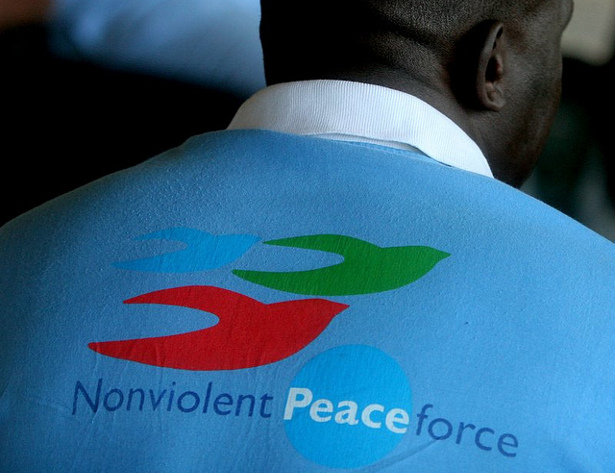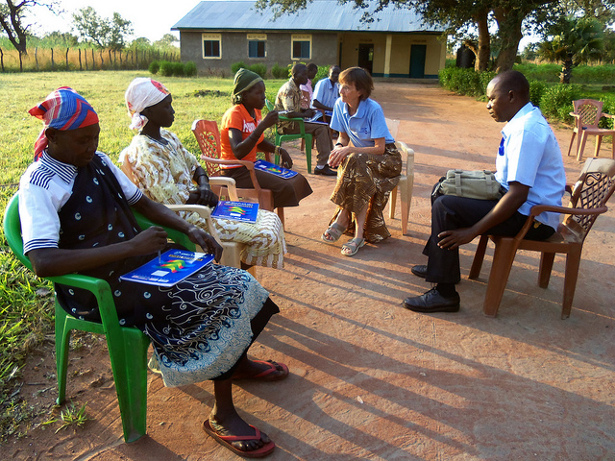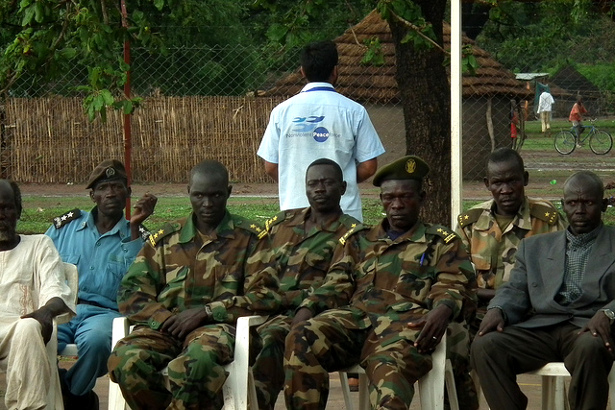By Stephanie Van Hook, from Waging Nonviolence
Kenyan Nonviolent Peaceforce worker Peters Nyawanda in Sri Lanka. (Flickr/Nonviolent Peaceforce)
Over the past few months there have been many discussions about alternatives to war and armed military intervention in light of the ongoing crisis in Syria. Those opposing military force have made alternative proposals that have included the work of unarmed civilian peacekeeping. In order to better understand what this might mean, I spoke with two unarmed civilian peacekeepers with the organization Nonviolent Peaceforce, Lisa Fuller and Tiffany Easthom.
Fuller is a field team leader for Nonviolent Peaceforce. Her work as an unarmed civilian peacekeeper has taken her to Sri Lanka and, most recently to Abyei, the area between Sudan and South Sudan, and the state of Jonglei in South Sudan. Currently she is working on a fundraising project to explore sending unarmed peacekeepers to Syria. Easthom is country director of the Nonviolent Peaceforce South Sudan project.
To start off, tell us about Nonviolent Peaceforce and what you do.
LF: Nonviolent Peaceforce is an international humanitarian organization that was started in 2002 with the idea that there was an alternative to either doing nothing or going to war. We started in Sri Lanka with the idea that international presence would be a way to deter violence and to protect civilians who were under threat. In Sri Lanka there was a 26-year civil war, but both sides cared very much about international opinion. So if there was a civilian or community under threat, and if you put internationals next to that person or those people, they would generally be safe because neither side wanted to be seen as attacking them.
Where are the internationals from?
LF: We try to have as diverse a collection of peacekeepers as possible. They are literally from all over the world — from six continents. I work with people from Africa, Asia, South America and Europe, as well as with people from North America.
Without the protection of weapons, how do you stay safe?
LF: We won’t go into any country to start a new project unless we have an invitation from a civil society organization. So that provides the basis for entering the country. As far as opening different field sites in different communities, we do an assessment beforehand. We meet all of the parties involved. We explain who we are, we ask them if they think that we would be useful or valuable or if they even want us there. And it’s only if they do, and if we think we can help, that we go in.
Community acceptance keeps you remarkably safe. But in order to be able to work, we need all of the actors involved in or affected by the conflict to know who we are. They don’t necessarily have to like us, but they do have to accept our work, view us with respect and understand that we are adding something valuable. In my experience, most parties do like us, despite the fact that we’re non-partisan. I actually feel safer working for Nonviolent Peaceforce than I think I would working for some other organizations.
Most recently I worked in Abyei, a disputed territory between Sudan and South Sudan. And there were areas where no other international organization would go because when they did they would receive threats. We never received any threats, and it’s because we had done the legwork in terms of building relationships. Those relationships provided the basis to allow us to be secure enough to go where we wanted to go.
Why is the Nonviolent Peaceforce in South Sudan and Abyei?
LF: South Sudan is the world’s newest country. It became independent in January 2011 after over 50 years of civil war. The vast majority of the population assessed this as a huge victory — something that they had wanted for a long time. But after independence was gained, internal divisions became apparent. South Sudan has 64 tribes, and they all have unique cultures and unique languages. Although there were divisions and conflicts among them before, the tribes generally put those aside and united against the common enemy of Sudan. But once that common enemy disappeared, they started to focus on the differences between themselves, and inter-tribal violence broke out. It’s hard to describe one particular conflict, because the sad fact is that most of those tribes are now involved in some conflict in one form or another. Because the government is so new and the country is large, there are places so inaccessible that rule of law really isn’t available, which allows armed conflicts to continue.
Can you describe the involvement of women in communities where you worked?
LF: They’re not involved in terms of being the actual fighters or combatants. I’ve never heard of a woman having a weapon and attacking someone. They are involved mainly as victims, especially in areas where the conflict has gotten particularly acute. Sometimes women and children are targeted as a tactic of war. But they’re never the ones that do the fighting.
We have 10 field teams in South Sudan, and different field teams do different work. There were some teams that created separate women’s peacekeeping teams. On my team we worked closely with a woman leader in our area. One of the things we did was when civilians were being targeted was to set up security meetings so that the community could meet with different security actors — like U.N. peacekeepers and police and the military — and to tell them about the security situation. Those security actors could then adapt their strategies to make those civilians safe.
Nonviolent Peaceforce training at Yeri, South Sudan, in November 2011. (Flickr/Nonviolent Peaceforce)
At the first two security meetings we had no women showed up. It was only men. So we spoke to a woman leader. We asked her if we could have a security meeting for women specifically. We asked her if there was anything we could do to help her organize that. She said don’t worry, just show up at this day on this time, and we did. She had almost every single woman in that community at that meeting, which was more than a number of men who would show up. It was a remarkably successful meeting.
The women said this was the first time they had ever gotten together to talk to a security actor about their security. Even the military and police said it was the first time they’d ever talked to women about their security, and they found out so much more about what was needed in those communities, because it’s the women who spend more time at home. They know what the threats are better than the men who go off to different areas for work. These security meetings, in combination with other strategies that we developed with the local chief and the leading woman, were remarkably effective. The incidences of rape and sexual assault, and actually of all other types of violence, were completely eliminated from the area as soon as the strategies were implemented. This impact was confirmed both by police and U.N. police advisors, as well as by the community itself.
How does unarmed civilian peacekeeping restore relationships among actors in a local conflict?
LF: Abyei is probably the best example. In this area the nomadic tribes and the Dinka are often in conflict. When people talk about them now, it’s as if these are two tribes that have always fought and have nothing in common, and there’s no hope for making peace. But if you actually talk to the people on the ground they’ll tell you the opposite. They’ll tell you, “I’ve known these people my entire life. Every year we sit down and have tea and visit with each other, and the only time this stops is when there’s a greater conflict around us in which people are too embarrassed to see each other or too scared to see each other. But really, in the end, we just want to sit down and have tea or coffee together.”
Since both of those groups trusted us, they were able to sit down and drink coffee if we were there. Sometimes that was enough. In a small community, for the community and the nomads to get together and realize that these were people they’d known all their lives, they realized there was no reason to defend themselves at all.
How do you approach the conflict differently than other forms of international intervention do? What about the conflict in Syria, for example?
TE: It is really important to illustrate the complexity of conflict in general and particularly a conflict like the one in and around Syria. Those on the outside tend to see the issue as one thing — the government against the rebels. What is important to highlight that in every conflict there are multiple layers. A war creates conditions whereby opportunistic violence arises; long-standing grudges are meted out during the confusion and cover of war, and displacement creates massive vulnerabilities for civilians. There are also peace and ceasefire agreements in communities throughout the conflict that are never really noticed by the general public, and these are often the most effective ways of bringing about increased security for civilians who are waiting for a political solution. Based on previous experience, this is an area where Nonviolent Peaceforce could be quite effective.
Do you think that unarmed civilian peacekeeping is limited in any ways?
LF: Absolutely there are limits. There are places that unarmed civilian peacekeeping is effective and there are places that it probably wouldn’t be safe or effective. Nonviolent Peaceforce has 24 criteria that we analyze before going into a country to help us decide whether or not it is appropriate and safe, and whether or not we will be able to protect people. In May we began a scoping process in Syria. We will follow that up with additional visits in October and November, when we will meet with potential partners and discuss and analyze possibilities.
A Nonviolent Peaceforce worker at a community meeting in Sudan in June 2011. (Flickr/Nonviolent Peaceforce)
We met with a variety of people on the visit in May including government officials, religious leaders, nonviolent activists, members of the Free Syrian Army, refugees, internally displaced people and representatives from the U.N. and Syrian Arab Red Crescent. Most agreed that unarmed civilian peacekeeping was needed but there was wide disagreement as to when. Some people said, “Come now.” Others said to send people now would be suicide. Most agreed that the time to start organizing and training is now.
What kinds of activities would you carry out in Syria if you decide to take on this mission?
LF: Activities could include accompanying people under threat because of their peace and human rights work or providing a protective presence in zones of peace, schools or hospitals. We might be able to work with communities in setting up early warning and early response mechanisms. Also, we have had numerous requests for training of trainers in unarmed civilian peacekeeping.
The project certainly seems daunting. How do you overcome that feeling?
TE: Conflict is complicated, and the international community often becomes so hypnotized by this complexity that inaction becomes more common than action. But the reality is that there are always entry points for violence reduction if you are willing to look for them and do the analysis to see them. We must break through the false dichotomy that the options are either to do nothing or to send in the bombers and cruise missiles. There are always alternatives. Unarmed civilian peacekeeping may be one of them.












[…] By stephanie […]
[…] Can unarmed peacekeeping work in Syria? It has in South Sudan by Stephanie Van Hook […]